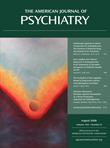To the Editor: In the March 2008 issue of the
Journal, Sabine Wilhelm, Ph.D., et al.
(1) reported that
d -cycloserine augmentation enhanced the efficacy of behavioral therapy for treating obsessive-compulsive disorder (OCD).
d -Cycloserine is a partial agonist of the glycine site at the
N -methyl-
d -aspartate (NMDA) glutamatergic receptor. Occupation of the glycine site at the NMDA receptor is required in order for NMDA agonists to fully activate the receptor. Since the NMDA receptor is crucial in the domains of learning and memory, the Wilhelm et al. study sought to enhance the learning that occurs during behavioral therapy sessions by potentiating the NMDA receptor via stimulation of the glycine site using
d -cycloserine.
d -Cycloserine is effective in stimulating the glycine site only within the narrow range of low doses (50–125 mg daily [1, 2]), acting as a partial glycine agonist. At higher doses,
d -cycloserine does not show efficacy
(3) and can exacerbate schizophrenia symptoms
(4), since
d -cycloserine blocks full activation of the glycine site at these doses, acting as a full glycine antagonist. In contrast, full agonists such as glycine and
d -serine stimulate the glycine site more potently and improve learning and memory more effectively within the high-dose range, as shown in their efficacy in the treatment of cognitive symptoms in schizophrenia
(4) . Thus, full glycine agonists are likely to be more effective and safer relative to
d -cycloserine in augmenting behavioral therapy for the treatment of OCD.
Dr. Wilhelm et al. stated that the efficacy of
d -cycloserine augmentation of behavioral therapy was more powerful early in the treatment of OCD, and this efficacy was decreased with prolonged treatment. The authors generalized this conclusion to
d -cycloserine augmentation trials in the treatment of Alzheimer’s disease and schizophrenia patients, stating that long-term use of
d -cycloserine “has yielded generally disappointing results” (
1, pp. 338–339). However, in these trials, the lack of efficacy of
d -cycloserine augmentation was likely to have been associated with the nature of
d -cycloserine as a partial glycine agonist
(4) . Additionally, these trials concluded that glycine agonists began to show efficacy 2 weeks from the time of drug treatment, and their efficacy was measured biweekly for 6- to 12-week trials
(4) . This time frame is clearly different from the time period for
d -cycloserine augmentation in the treatment of OCD, in which the efficacy of
d -cycloserine was measured per an hourly basis. This discrepancy indicates that neuronal mechanisms underlying
d -cycloserine augmentation of behavioral therapy for OCD and the augmentation of antipsychotic drugs with glycine agonists for treating schizophrenia and Alzheimer’s disease may be different.

